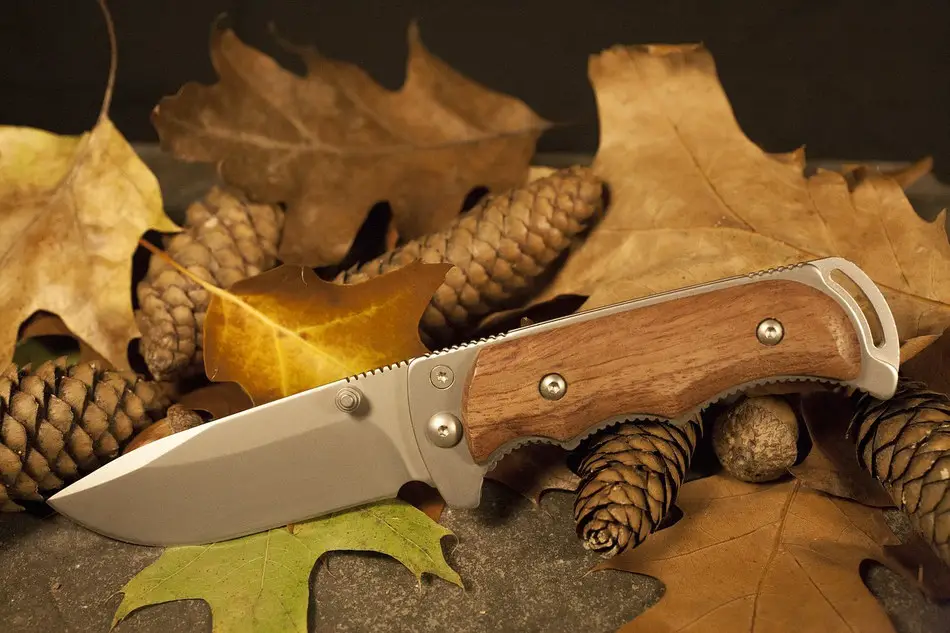Survival knives can be a vitally important tool in a variety of situations. Whether roughing it in the woods or prepping for the worst, a good tactical pocket knife will serve you through thick and thin. While it’s easy to get lost in the claims which type of survival knife is the best for you (every brand will insist that theirs is the best), it is important to do your own research. Which is exactly what I did in this very article, and I hope it will prove to be useful to your knife-related choices. I also took this subject one step further and listed all possible characteristics of a survival knife and how you can take care of it.
First, just a few examples of what a good survival knife can do for you. You can utilize it to:
- Open cans and food packages
- Cut bandages to dress wounds
- Cut wood in order to start a fire
- Construct a basic shelter
- Carve additional tools
- Clean fish, skin an animal, and prepare your food in many other ways
As you can already see, a good knife is an irreplaceable part of your survival gear. Now let’s see what types of knives there are. I will also recommend some of the best (in my humble opinion) survival knives in every category and link to their Amazon pages.
Every Possible Type of a Survival Knife
Boot Knife
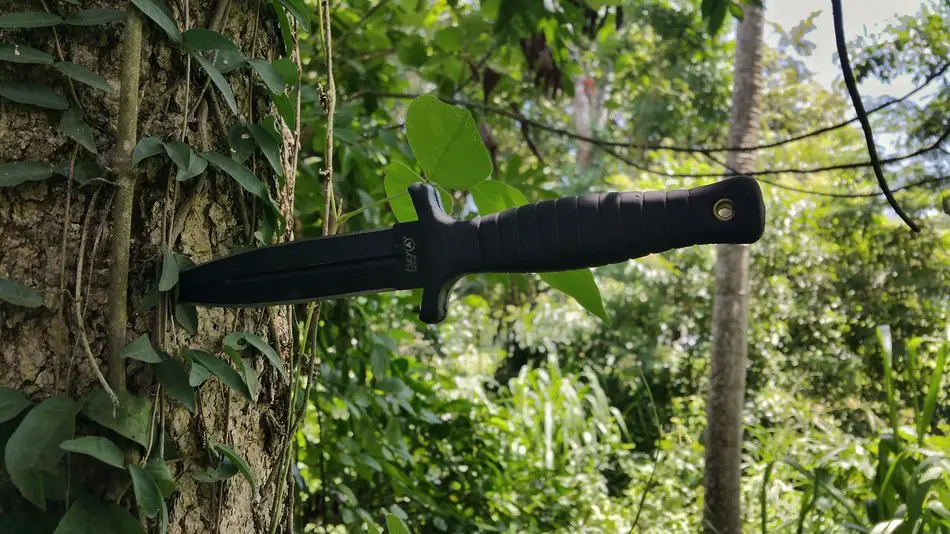
A boot knife is exactly what it says: a tactical pocket knife designed to be easily concealed in a boot. Boot knives are easy to conceal, both because of their namesake hiding spot, and because they can also be slipped into a belt, under a pant leg, or worn around the neck. Typically, these knives are double-edged and up to five inches long. This is why the boot knife can probably be easily considered the best survival knife.
Because they are short, boot knives are not the best candidate for a primary survival knife. However, since you can carry them naturally in the easily accessed places, it makes them a prime candidate for a trusted backup knife, especially for situations where you might find yourself backed into a corner. After all, nature isn’t the only thing you can brandish a knife at for your own protection, and a boot knife would be an excellent go to when confronted by mugger or some other threat to your personal safety. The same might be said of any knife, but the boot knife has the strength in concealment to back it up.
There is a number of situations, in which a boot knife can successfully assist:
- Survival – use the boot knife to cut a rope, slice pieces of clothing to make wound dressings, cut through a seatbelt if someone is trapped in a car, and so on.
- Self-defense – as mentioned above, it can be hidden on you and then be used in cases of certain danger from an attacker. I do not advocate violence! However, there could come a time when you and your loved ones are threatened. A boot knife can be an unexpected, yet reliable line of defense.
- Hunt – this type of a survival knife if particularly useful in hunting, when there is no room for a larger knife.
- Common chores – use the boot knife to make the fish ready for cooking, to open zip ties and packages, to pull out staples, to slice cloths, etc.
So if you are looking for a high quality boot knife, I can strongly recommend Old Timer 162OT Boot Knife:
- Made of reliable high carbon stainless steel
- Quickly accessed thanks to the leather belt sheath
- 7.8 inch long, 3.8 inch blade and a 3.9 ounces weight
- Secure front prevent the blade from slipping
- Full tang design
Buck Hunting Knife
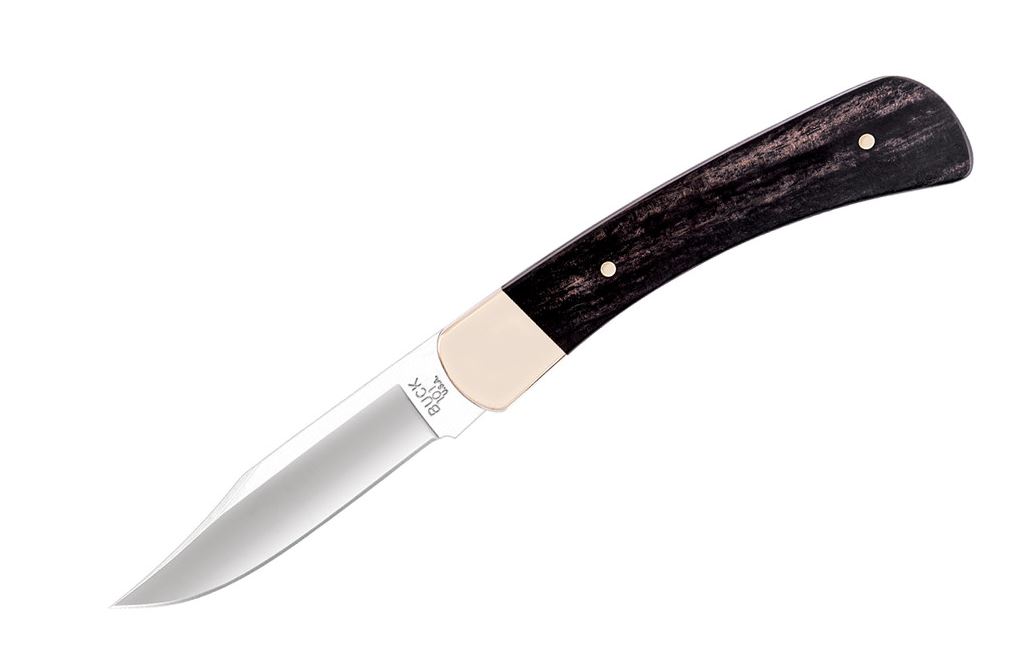
The buck knife is an excellent multipurpose knife that can help you skin, chop, build, or defend yourself. It features a fixed blade, making it an overall sturdier choice when it comes to wear and tear. The buck knife is not exactly primarily used for hunting, but rather for skinning the game once it’s down for the count. While intended for hunting originally, a buck knife features a slightly thicker blade than normal hunting knives in order to be used for assorted tasks necessary in a survival situation.
One of the best buck hunting knives in existence is Buck 692BR Vanguard Fixed Blade Knife:
- Its steel blade has superb strength, edge retention, and corrosion resistance
- Smartly designed: full tang, finger guard, deep choil
- Perfect for outdoor travels and hunting
- Anti-slip grip and great balance
- 8.5 inches in length, 6.3 ounces in weight
Consealed Knife
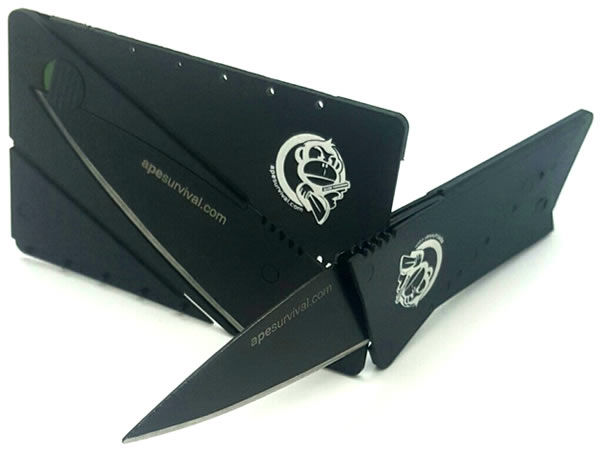
While technically almost any knife can be consealed, this category refers to particularly small and discreet knives. These knives are sometimes disguised as other commonly used objects. They can be easily hidden under your clothes or even in a wallet. They can be used in self-defense or when you need to quickly cut something.
The consealed knives’ quality and durability vary between different models. Luckily for you, I found 3 websites that give high-quality knives away for free. Some of them will ask you in return to join a mailing list, or pay just for the shipping. So make sure you are aware of the terms when you request your free knife.
Card Knife is a small and discreet knife shaped like a credit card. It’s made of surgical blue steel and can turn into a blade in one second.
Neck Knife is a great EDC knife. It’s lightweight and can unobtrusively hang from your neck. Its highly sharp blade is partially serrated. The Neck Knife comes with a secure blade cover and stainless neck chain.
SharpCard is similiar to the Card Knife. It’s utlra-slim, waterproof and rust proof. The linked site actually gives you not one, but two knives for free!
Combat Knife
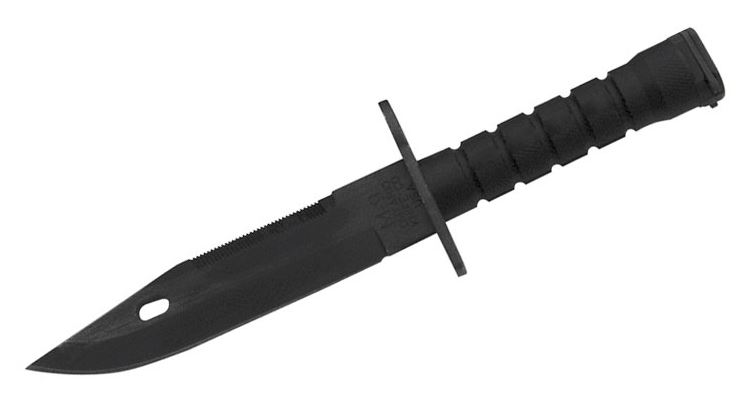
A simple fact: everyone runs out of bullets eventually. Which means military enthusiasts might be interested in a combat survival knife. Used by every level of the armed forces, a combat survival knife is designed to be handy in a variety of situations. This type of knife is designed to be durable, so that it can be a long lasting useful tool that can save a life in a sticky situation. Whether you’re on the battlefield or out in the back country, a combat knife will likely serve you exceptionally well through a hairy situation.
The best combat knife that you can find anywhere is Smith & Wesson SW3B 12.8in Fixed Blade Knife:
- 14.6 ounces, 12.8 inch overall length with 7.8 inches blade
- Extremely durable powder coated black oxide stainless steel
- Textured and grooved handle made of nylon fiber
- Quickly accessed thanks to the large pouch
- Also comes with a sharpening stone and wire cutters
Military Knife
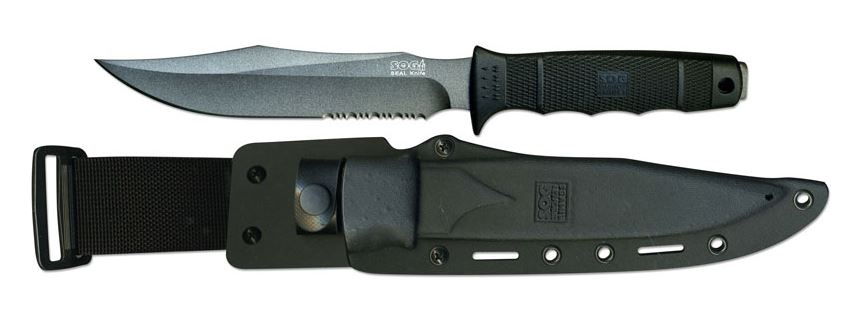
Another option for military enthusiasts is any knife from the U.S. Military. The branches tend to have their own unique choices for standard issue military knives, so there’s a decent selection to choose from. For example, the official USMC fighting knife is a 7″ Ka-Bar knife. A gun is easily the most obvious tool when it comes to soldiers, but fixed blade survival knives have so many more uses in situations where a gun is simply not effective. A gun can suffer from a breakdown or run out of ammunition. A good, fixed blade knife isn’t going to have those issues. A military survival knife can be used for everything, from digging a hole to food preparation. A knife can easily help a soldier survive on the battlefield, or help you through an intense camping trip deep in the wilderness.
The best military survival knife is definitely SOG Fixed Blade Knife with Sheath:
- Serves as a survival knife, a hunting knife and also a tactical knife
- Stainless steel, full tang, 7 inch and 10.3 ounces
- Great grip thanks to the glass-reinforced nylon that requires no maintenance
- Strengthened with cryogenic heat treatment
- Comes with a tough nylon sheath
Ka-Bar Knife
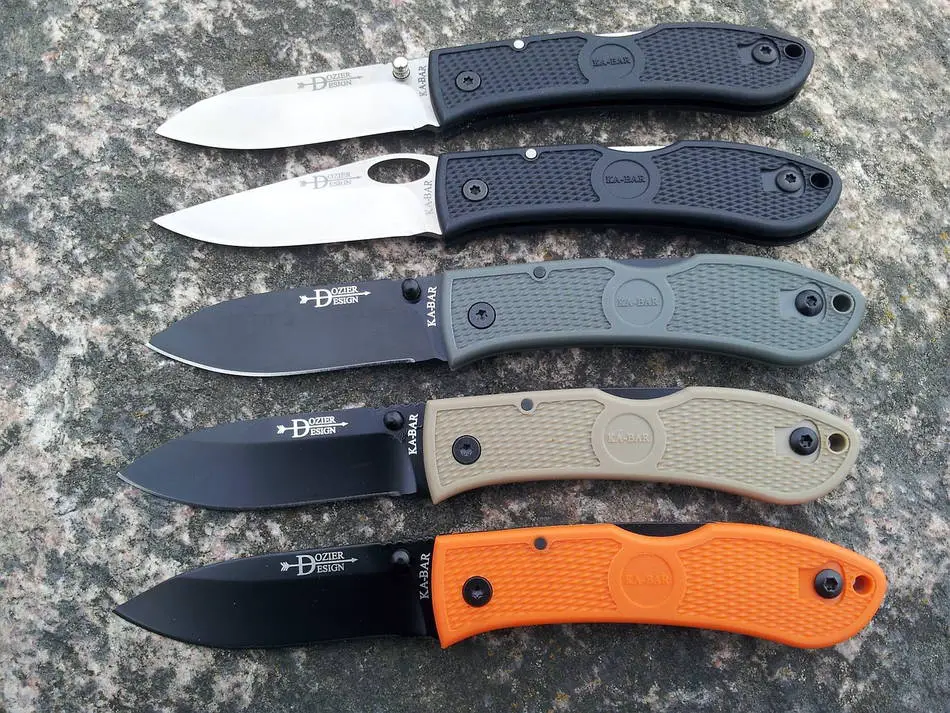
This interesting type of survival knife is issued to US Marines. It usually has a sturdy leather handle and a fixed, single edge blade. The Ka-Bar fits a hand perfectly and is designed to do all the hard tasks, such as prying, digging, and so on. Additionally, its blade tip has the shape of diamonds, which makes this knife especially strong and stable when stabbing an attacking enemy. So not only is this a great survival and hunting tool, but it also serves you as a legit weapon.
If this type fits your needs, I would recommend to get Ka-Bar BK-10 Becker Crewman Fixed Blade Survival Knife:
- Made of 1095 Cro-Van steel
- 5.5 inches straight edge blade
- Full tang, fixed blade, very easy to handle
- Comes with a front pocket sheath
- Made of durable and highest quality material
Rambo Knife
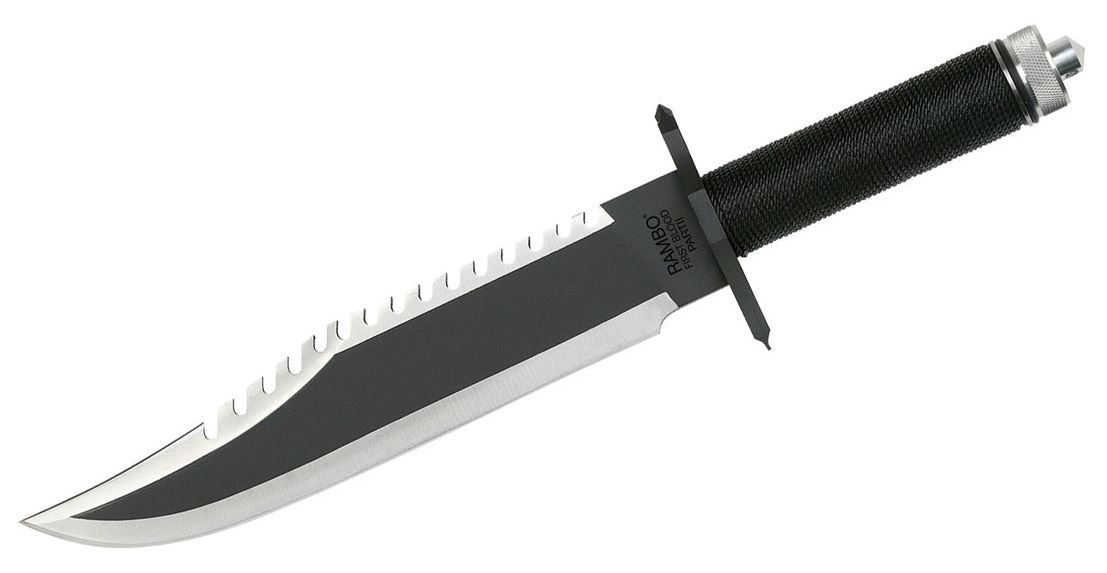
A Rambo knife is most often a hollow handle survival knife with a serrated edge. The Rambo knife rose to popularity in part due to the famous action movies, in which Vietnam veteran John Rambo is seen wielding a large survival knife. Not only does the movie series associate this large survival knife with a paragon of survival and masculinity, but it also displays the many ways the knife can be used.
You can actually purchase the Officially Licensed Rambo II MC-RB2 Survival Knife:
- High performace and durability
- Built of quality materials
- Has a concealed compass inside the handle cap
- Comes with a sheath that can be tied to your leg
Folding Survival Knife
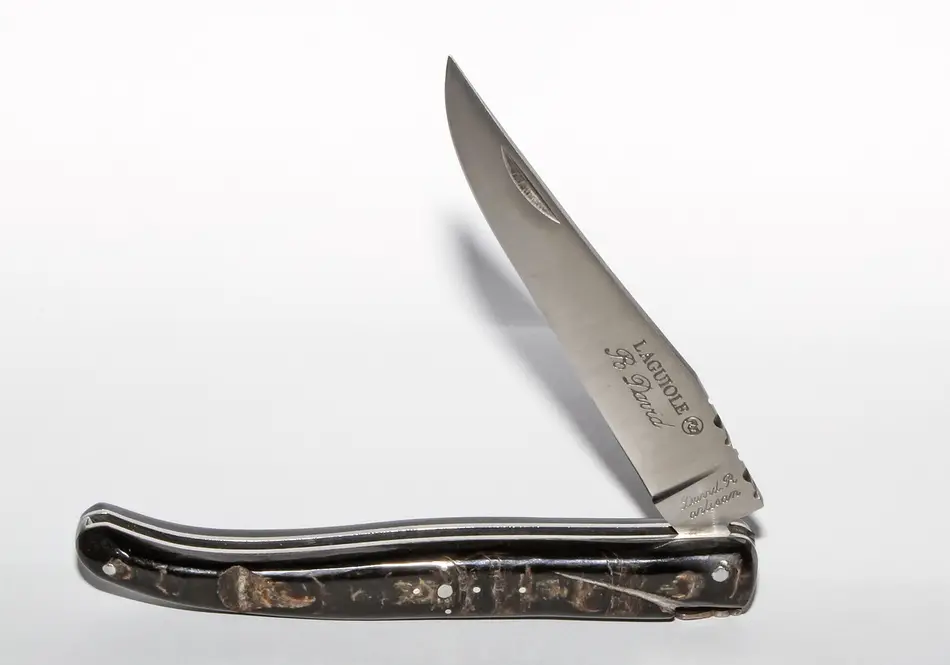
When it comes to durability and reliability, a folding survival knife isn’t the first one that comes to mind. But when convenience is in demand, you’ll be hard pressed to find anything superior to this knife type. What folding survival knives lack in strength, they make up for by being able to slip easily into a pocket. Perfect for the situation where carrying a large survival knife simply isn’t feasible, a folding survival knife is ideal for having on hand. After all, having a knife on you and not needing it is better than not having one with you when it turns out that you do need it. That’s just common sense.
One of the best folding survival knives is SOG EDC Pocket Knife:
- Built to last – highly durable
- Versatile knife, perfectly suitable for daily use
- 4.5 inch handle
- 3.5 straight edge sharp blade
- Glass-reinforced nylon grip
Another highly rated folding knife is Kershaw Blur Black:
- Easy and safe opening with any hand
- Easily stored and can be discretely carried
- Supersharp blade, can be used any time and anywhere
- Liner Lock adds safety, durability and strength
- Quality grip, can withstand any condition and weather
Tactical Knife
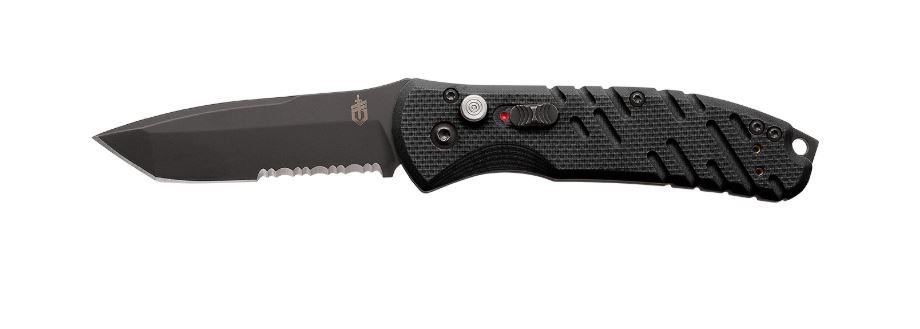
A tactical knife is one knife where you don’t want to compromise on quality, because it must work both as a tool and as a weapon. Designed with the intent to be useful both in completing household chores and in parachuting into a thick jungle in the dead of night, a tactical knife is a reliable tool to have on hand. It’s another knife that was designed with our troops in mind. Tactical knives may not be exciting to look at, but they are designed to last. You will certainly notice how much abuse your knife takes and how often you need to sharpen in. These knives are less likely to break in a life or death situation, and will serve you well throughout their life.
One of the most recommended tactical knives is Smith and Wesson SWBLOP3TS Third Generation Black Ops Knife:
- 3.4 inch blade, 7.7 inch overall length, weighs 4.8 ounces
- The blade is Black Oxide High Carbon Stainless Steel
- Great for everyday use
- Dependable and convenient, has ambidextrous thumbs knobs
- Secured by liner lock + safety lock
Tanto Knife
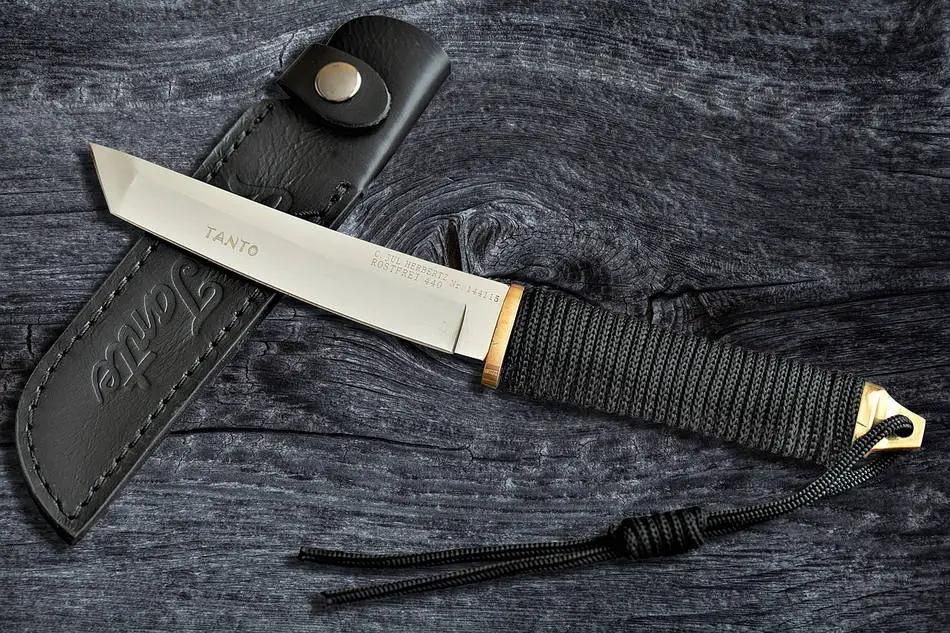
Even though the tanto knife style was popularized in the eighties by Cold Steel, its history can be traced back to Japan where it was a traditional blade designed to pierce armor. Also known as the Japanese short sword, the tanto knife resembles a samurai sword and is strong enough to withstand repeated use. It features a reinforced end that makes the blade incredibly strong and the knife tip incredibly difficult to damage. Since the tanto knife is based after the traditional blade, it stands to reason that this knife inherited some of the piercing skills that its history boasts, and can easily hold up to tasks that another survival knife might not be up to. The tip has a chisel-like effect to it that is perfect for prying or scraping. Cold Steel continues to produce the highest quality of tanto knives on the market.
One of the best tanto knives today is KA1245-BRK Black Tanto:
- Thick pointed blade easily penetrates its target
- Glass-filled nylon sheath
- Ideal even for the toughest tasks
- 8 inch fixed blade, 12 inch overall length
- Firm, durable handle made of Kraton G material
EMS Knife
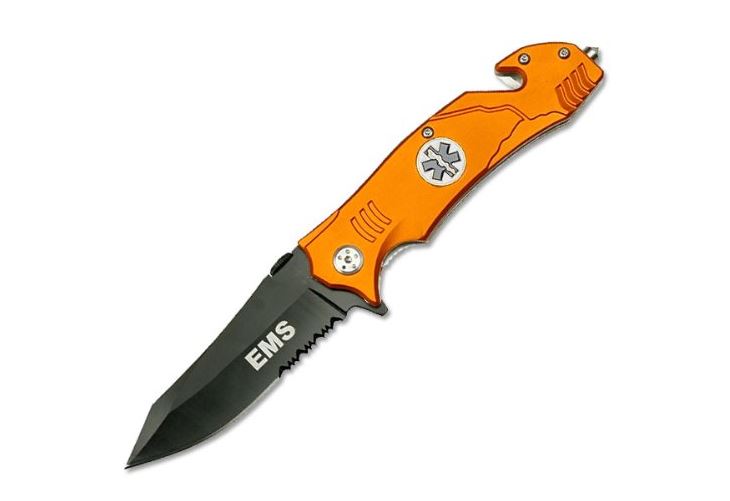
Emergency medical services (EMS) include paramedics, EMTs, police, firefighters, and sometimes even the military. They are the ones who respond first when an accident takes place. And some of them are equipped with the EMS knife. This knife can be effortlessly opened and used with a single hand, which is very important in an extreme situation. Its belt clip makes it possible to hang the knife from any part of the uniform. The blade is just the right size, not too big and not too small, which makes the work done with the knife much easier. You can even bring it on a hiking trip.
The EMS knife’s frame has a small bump at its base. This pointed protrusion helps turning the knife into an effective glass breaker. If you grab the knife inside a fist and strike a window, the glass will break and a person trapped inside can escape. It can also be used to cut a seat belt. These are just some of the examples how the emergency services use this type of a survival knife.
A great and recommended EMS knife is the Snake Eye Tactical Spring Assisted Knife:
- Highly rated and widely used pocket knife
- 3.25 inch stainless steel blade, 3mm thick
- The blade is also black and half-serrated
- Comes with seat belt cutter, glass breaker and pocket clip
- Carried by various rescue agencies
Throwing Knife
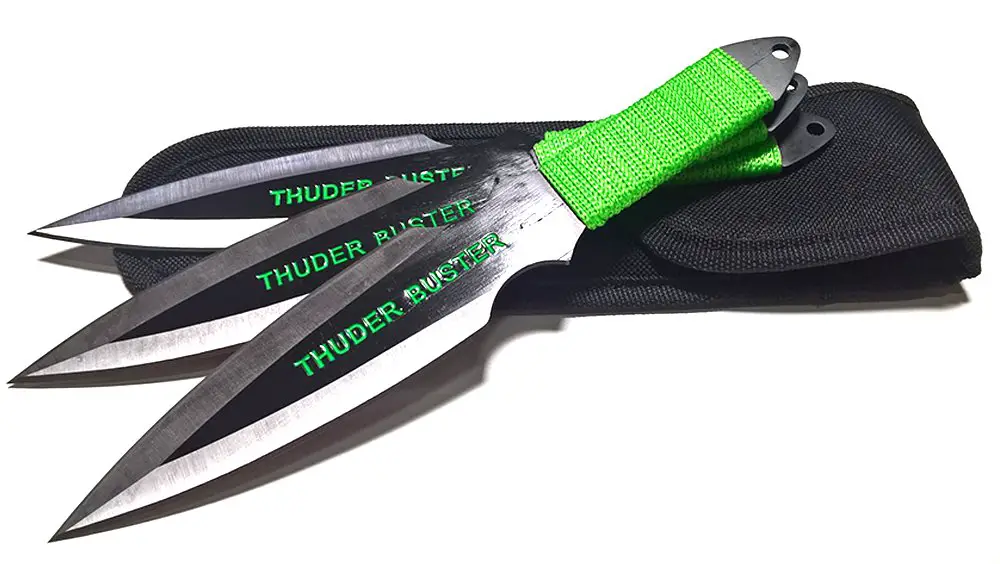
A throwing knife is best used for the purpose of distracting the enemy. You could try to hunt small animals with it, but in general, its killing abilities are limited. The knife is usually thrown at the attacker, so that the enemy’s focus is broken, and then you can follow by striking your enemy down with a different weapon.
Throwing knives come in different sizes. Some are no bigger than the palm of the hand, while others are so big that they require a separate bag. They mostly have a bare of skeleton handle. Adding a handle wrapping or a grip negatively influences this weapon’s trajectory. Most of the knife’s weight is concentrated in the front, to ensure that its point is the part that hits the enemy when the knife is thrown.
I would strongly suggest that if you choose to carry throwing knives, then you should consistently exercise at throwing them, preferably on a daily basis. It’s not an easily acquired skill, but with a constant training you will definitely learn it.
A good choice for a throwing knife is SOG Throwing Knives with Sheath 3 Pack:
- Known for their balance and precision
- Excellent starting point to practice knife throwing
- Hardcased black stainless steel
- Multi nylon sheath to securely carry all 3 knives
- Removable paracord for additional balance
The Ultimate Survival Knife and Its Parts
The ultimate survival knife is the knife that you feel will best serve you through the variety of tasks. There are several key factors to keep in mind when choosing the knife that will become your trustworthy companion. When you start to shop for a knife, it would be wise to keep the following seven factors in mind.
1. Size
The size of the blade will greatly influence what you can use the blade for. As stated earlier, the boot knife is only five inches long on average at the maximum. In survival, you’d want a blade that’s small enough to be precise, but big enough to complete more rugged tasks like chopping. The usual length you should be keeping in mind is nine to eleven inches, because that will give you the widest usage range. The medium size range is where the best survival knives are.
2. Blade
As you choose your survival knife, a very special attention should be given to the design of the blade. You can get a folding blade knife, but you’ll be trading durability for convenience. A fixed blade has a much stronger lead in durability, especially when it comes to tasks like chopping, batoning, and splitting. A fixed blade will stand up better to abuse than a folding knife. Ultimately, a folding knife will break if you use it a lot for survival. While it’s great for day to day carry, fixed blade survival knives are much better than any folding blade when it comes to the more intense side of survival.
When facing a real survival situation, the entirety of the blade (tip to belly) will probably be used. This is why I would recommended going mostly for a drop or a spear blade design. The reason is that such a design gives you better control by placing the tip near the blade’s center line. Additionally, such design diminishes the weight around the tip, and therefore the balance point is located near the hilt. Thus, you now have a better tip control.
3. Tang
The tang is the part of the blade that is wrapped in the handle. There are full tangs, partial tangs, rat tail tangs, and hidden tangs available, but the best choice for survival is commonly cited as the full tang. With a full tang, you can see traces of the metal all around the handle, whereas the other three don’t show that much metal in the handle. This makes a major difference in durability, and a knife with a full tang is going to be much sturdier than a knife with a partial or hidden tang.
A full tang knife can also be salvaged better than a partial tang in the chance that the handle breaks off. A partial tang with a broken handle can become dangerous and inadvisable to use, but a full tang can be wrapped in cord and continue working just as well as before the handle broke. The price goes up with a full tang, but it’s a price increase that pays off in the end by amplifying durability and longevity.
4. Tips
The tip of the knife can make a huge difference. While it might be tempting to get a knife that has a cool design to the blade, the levels of badassery you feel aren’t worth it when the blade sacrifices function in order to be unique. When it comes to a decent survival knife, you’re probably not looking for something that would be better suited as a Halloween accessory. You’ll find a trustworthy and useful tip in a spearpoint or a drop point. Sacrificing the funky style of a blade for the more classic spearpoint or drop point means you’ll fare better when using your knife for self-defense, or when you’re using your knife for fine point work.
5. Blade Type
There are three main types of blade that have their own unique benefits and detriments, and can be compared with ease. Double Edged knives, straight edged knives, and serrated knives each have their own strengths when it comes to survival, but for certain tasks (like wood splitting) a straight edged knife is preferable. A straight edge or single edged knife has a flat side that you can use in batoning or for detailed control without worrying about losing cutting power or slicing your hand open. While double edge and serrated blades offer a cool look to them without sacrificing durability and usefulness, the straight edge still has a strong lead against them.
6. Butt of Handle
The blade isn’t the only part of the knife that can be used as a tool. The butt of the handle can be an excellent substitute for a light hammer. The best option is a flat butt, because having the option to use your knife as a hammer will help you drive stakes into the ground with ease. A hammer is a useful tool to have, and styling your knife to act as a substitute for a knife means you’ll have one less item to carry or worry about in an emergency situation.
7. Versatility
You might think that the best survival knife is the biggest, most serrated blade you can find. After all, these aggressive knives look like that’s what they’re made for. You’d be wrong, however, as a survival knife needs to be versatile in its purpose — meaning it should be able to do a lot of different things from chopping, to carving, to detail-oriented cutting tasks, and everything in-between. Therefore, simpler, smaller, more straightforward knives tend to be overall better than beefy tactical blades. Think of it like fishing: you could use a dynamite to fish and you might be successful, but at what cost?
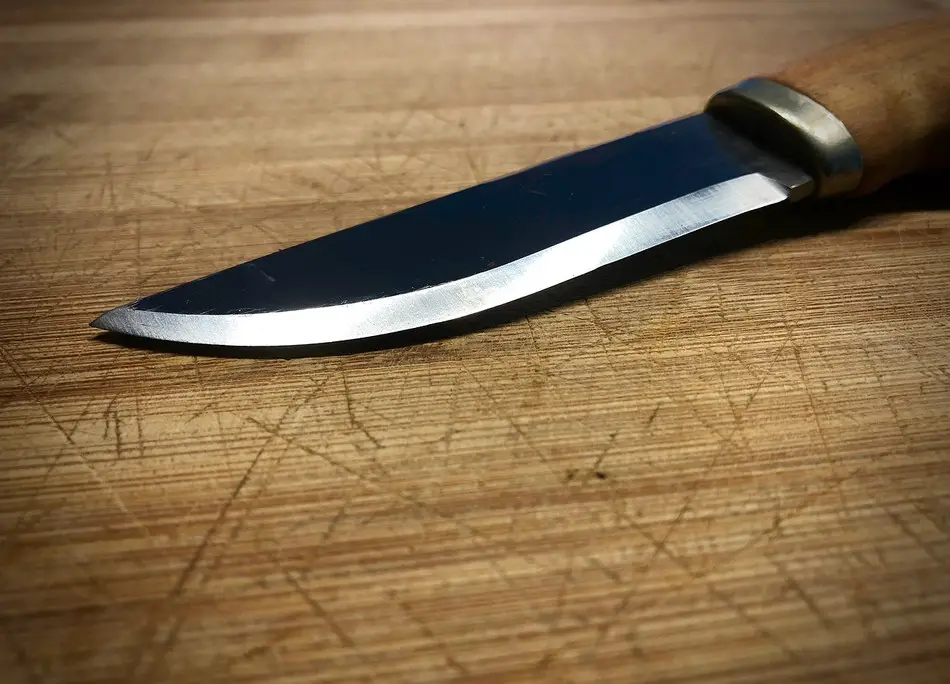
Taking Care of a Survival Knife
I’ve mentioned survival knife’s durability a few times, but it is also up to you to take care of it and make sure it keeps serving you for a long time. So here are a few useful tips on knife maintenance.
- Sharpening. A dull and blunt knife actually works against you in emergency situations and important survival tasks. It needs much more pressure to cut and pierce, and its controls are troublesome to say the least. Eventually it will wear you down and waste valuable time and energy. I will mention how you can keep it sharp under the next heading.
- Dryness. Always keep your knife dry. Just store it in a dry space, for the sake of keep it safe and long-lasting. Moisture can corrupt the blade, rendering it useless. It is also advisable to store your knife in a high spot, out of the reach of children.
- Cleanliness. Your knife should be clean at all times, after every task it performed. This will also ensure its longevity and high quality of its performance. Unclean knives are an invitation for dangerous bacteria to spread on their surface. Use running water with soap to thoroughly clean the handle as well as the blade from any dirt and wood sap. Afterwards, the knife should be completely dried before you return it into the sheath, in order to avoid potential rust.
- Oiling. You must oil your knife’s blade in order to minimize friction. This helps the knife to effortlessly enter and exit the sheath. A little bit of the common household lubricant or oil should be enough for this task.
If you’re serious about taking care of your knife, then I would recommend getting PriorityChef Knife Sharpener for Straight and Serrated Knives from Amazon. As the name suggests, this high quality yet very affordable tool sharpens absolutely every type of knife. The 2-stage diamond coated wheel system can bring even the dullest of knives back to life! This knife sharpener is ergonomically designed and extremly durable, therefore it’s easy to handle and it will serve you for many years to come. Click the image or the link and see literally thousands of 5 stars reviews that the sharpener received.
Sharpening a Survival Knife
There are 3 commonly known methods of sharpening your survival knife. Let’s have a quick look at all of them.
- Whetstone. To sharpen the blade using a whetstone, you need to sweep the blade against the stone’s surface (after it was moistened) until its edge is sharp once again. Afterwards, you can utilize much finer stones and bring the blade’s sharpness to whatever level you desire.
- Ceramic stone. This stone is considered being more portable and more comfortable for the purpose of knife sharpening. You move the blade through the stone’s channels, thus sharpening the two opposing edges simultaneously.
- Diamond. This one is more suitable for home use. This device is shaped like a rod, and you mainly move the knife against the rod until it’s as sharp as you need it to be.
Here is a good video that explains how to sharpen your knife in the wild:
Is It Legal to Carry a Survival Knife?
The laws that deal with knife carrying are sometimes unique to the country, state of even a city you’re in. Usually, the laws prohibit having a concealed knife in your possession. The rural laws, on the other hand, are not that strict, and you can take your survival knife into the wild. Then again, if you’re heading into a national park, then the rules are strict again.
The bottom line is, simply find out what the law in your area says before you decide to openly carry the survival knife.
In Conclusion
At the end of it all, there is a lot to consider when you’re choosing the survival knife of your dreams. Whether you’re a military-grade enthusiast, a knife collector, or a seasoned survivalist used to roughing it in the deep wilderness, there is a survival knife that can fit all your desires. It is always a part of crucial survival gear. While the options on the market might seem overwhelming at times, and it can be tempting to grab a knife that has strong advertising and branding, doing your research in order to find the best possible knife for you will always pay off.

